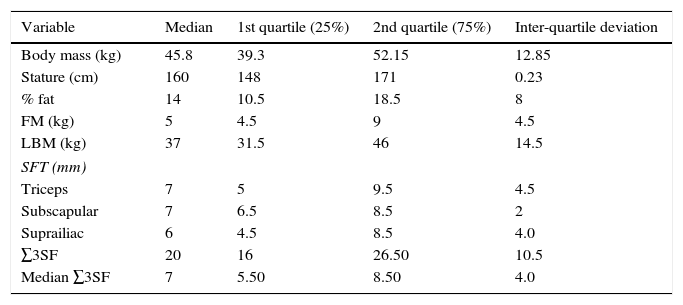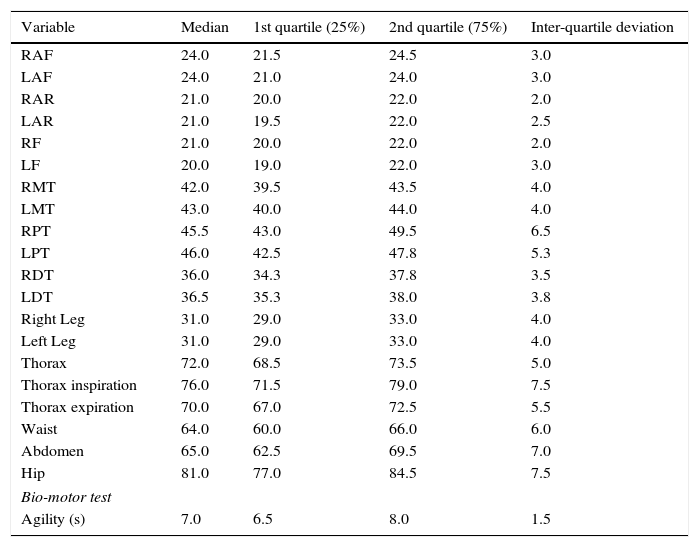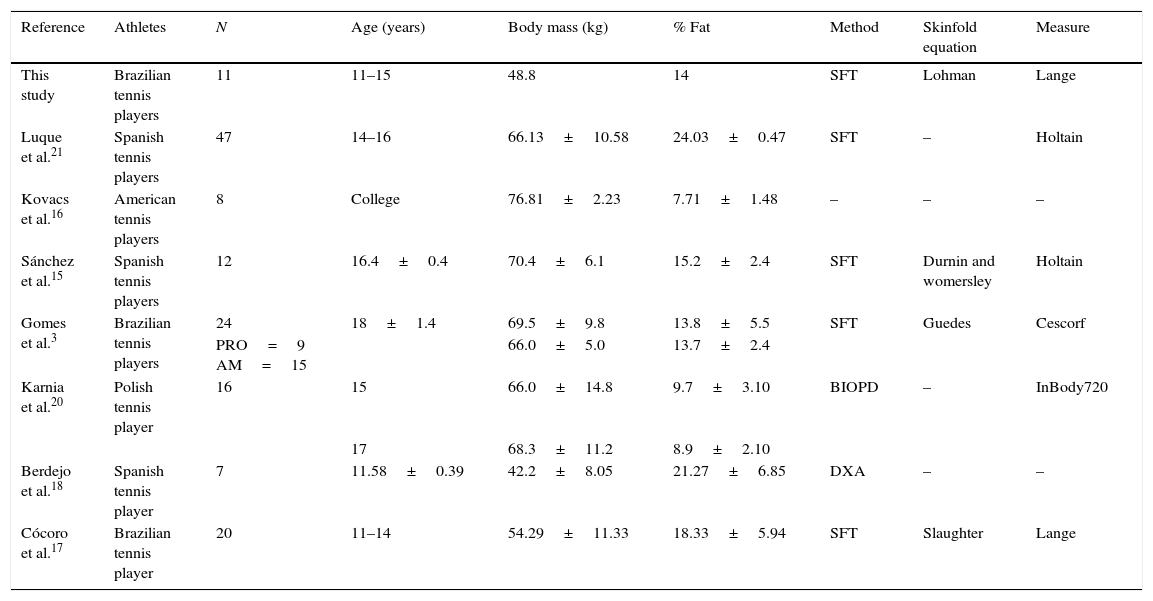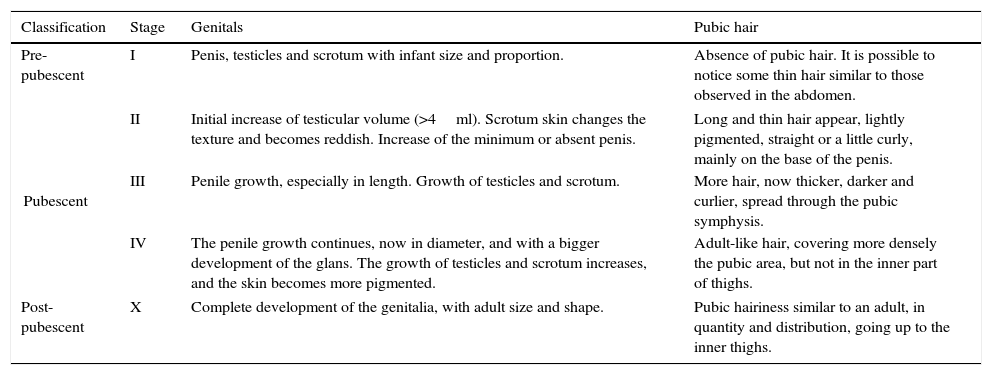Determine the motor and morphological characteristics of amateur tennis players from 11 to 15 years old.
Method11 male athletes from the Paranaense Tennis Federation were evaluated during the competition period. Anthropometric variables (total body mass, height, circumference and skinfolds) were assessed.
ResultsThe following median values were obtained: 45.8kg of total body mass, 160cm of height, fat percentage of 14%, lean mass of 37kg, and fat mass of 5kg.
ConclusionThe study concluded that athletes show a profile of body composition similar to the profile of tennis players of the same age.
Determinar las características morfológicas y motoras de jugadores aficionados de tenis de edades de 11a15 años.
MétodoFueron evaluados 11 atletas masculinos, afiliados a la Federación Paranaense de tenis, en periodo de competición. Se midieron las siguientes variables antropométricas: masa corporal total, altura, perímetros y pliegues cutáneos.
ResultadosSe obtuvieron los siguientes valores medianas: masa corporal total 45.8kg; estatura 160cm; 14% de masa grasa, 37kg de masa magra y 5kg de masa grasa.
ConclusiónLos atletas valorados en el presente estudio tienen un perfil de composición corporal similares al perfil de los jugadores de tenis de la misma edad.
Determinar as características morfológicas e motoras de atletas amadores de ténis com idade de 11 a 15 anos.
MétodoForam avaliados 11 atletas do sexo masculino, inscritos na Federação Paranaense de Tênis em um período de competição. Os atletas foram avaliados para as variáveis antropométricas: massa corporal total, altura, circunferência e dobras cutâneas.
ResultadosObtiveram os seguintes valores médios: 45.8kg para massa corporal total, 160 centímetros de altura, percentual de gordura de 14%, em massa magra de 37kg, e de massa de gordura de 5kg.
ConclusãoO estudo concluiu que os atletas mostram um perfil de composição corporal semelhante ao perfil dos jogadores de tênis da mesma idade.
The modality of field tennis is in constant growth and development in our country, and this ascension is due to the arising of Brazilian tennis players with international relevance like Gustavo Kuerten, from Santa Catarina. He has three Grand Slams awards, that was in Roland Garros and various Masters Series awards, making him first place in the Mundial Ranking of Association of Professionals Tennis Player (ATP) in December 2000.1 The practice of field tennis can be classified as intermittent effort during the game, respecting the energy supply.2 Therefore, it is suggested that what happens is a mixture of the aerobic and anaerobe energetic systems for energy supply.3
Moreover, the athlete's performance in a match requires physical abilities that allow him to make sudden and fast stops as well as to change direction. That happens due to the constant exchange of balls,4 that occurs in matches that the lasting time can change between 60 and 300min.2 Observing the behavior of the morphological variables over the perimeters of the right side of the body compared to the left side, different muscle asymmetries can be developed.5
Such matter is justified by the specificity of the modality that prioritizes the sidedness that can develop undesirable imbalances in long term such as increasing of strength and hypertrophy induced by sport, evolving to recurrent injuries or diminishing the functional capacity.6
Regarding the body fat percentage, when it is reduced it can be advantageous for the those who practice tennis due to the movements in court, very often being executed in bursting movements that require good levels of agility and velocity.7 It is important to point out that the explosive strength in the legs is imperative to obtain a good capacity of acceleration while the fast strength in the upper limbs is necessary to hit the ball hard.4
Having in mind that are only a few studies made with adolescent athletes, it is necessary to investigate the motor and morphological profile of these athletes in order to detect ideal patterns to the practice the modality. Determine the morphological characteristics of a amateur field tennis athlete with age between 11 and 15 years old.
MethodThis research is a transversal study that consists in 11 male individuals, with ages between 11 and 15 years old, amateur tennis players registered at the Federação Paranaense de Tênis, in competition period in Paraná. Such athletes had a routine of two and a half hours of daily practice. The search for the information happened in August, 2013, by a physical education professional, that belongs to a group of the Laborátorio de Bioquímica e Fisiologia do Exercicio da Faculdade Dom Bosco. The athletes were evaluated in pre-established days, for that were used the club installations, where the boys used to practice, those installations had the necessary infrastructure. In order to obtain a more homogeneous group, some exclusion criteria were adopted: (a) athletes who presented muscle and joint injuries during the evaluation process; (b) athletes who use medication that could affect the responses during physiological tests; (c) athletes who refused to attend the research. All participants signed the Informed Consent according to the CNS Resolution 466/12. This research has been approved by the Committee of Research Ethics at Dom Bosco College, under the CAAE – 0084.0.301.000-11.
The anthropometric evaluation was composed by measurements of total body mass (MCT), total height (ESTT), circumference, triceps skinfold (DCT), subscapular skinfold (DCSE) and suprailiac skinfold (DCSI). The MCT was measured in an anthropometric scale (Tanita Bf-680w digital monitor) with 100 grams resolution; the ESTT was determined with a digital stadiometer (Seca®, Hamburg, Germany) with measure from 0 to 220cm, 0.1cm resolution, considering as the final result the arithmetic mean of three consecutive measurements, with the individuals with no shoes and light clothes.
The skinfolds (DCT and DCSE) were measured three times with an adipometer (Lange®, Beta Technology Incorporated, Cambridge, USA) with scale from 0 to 60mm, 0.1mm resolution, in the right hemibody, considering the final result as the arithmetic mean of the measurements. The DCT was obtained vertically in the midpoint of the length of the right arm between the acromion and the olecranon. The body adiposity was estimated by the pubescent equation, such protocol is recommended to kids and adolescents from 11 to 15 years old.8
Pre-pubescent=G%=1.21 (S) – 0.008 (S)2 – 1.7
Pubescent=G%=1.21 (S) – 0.008 (S)2 – 3.4
Post-pubescent=G%=1.21 (S) – 0.008 (S)2 – 5.5
S=sum of folds: triceps and subscapular.
To evaluate the perimeter, it was used the anthropometric tape (Cescorf) with 2m of length and 0.1cm resolution. The following perimeters were evaluated: relaxed arm, contracted arm, forearm, thorax in inspiration position, thorax in expiration position, waist, abdomen, hip, proximal thigh, medial thigh, distal thigh and calf.9
The stage of development of the external genitalia was evaluated through the test,10 in which athletes were individually evaluated based on self-evaluation in a room where photos displayed where it was presented peculiar sexual characteristics to each development stage. They were classified in:
| Classification | Stage | Genitals | Pubic hair |
|---|---|---|---|
| Pre-pubescent | I | Penis, testicles and scrotum with infant size and proportion. | Absence of pubic hair. It is possible to notice some thin hair similar to those observed in the abdomen. |
| Pubescent | II | Initial increase of testicular volume (>4ml). Scrotum skin changes the texture and becomes reddish. Increase of the minimum or absent penis. | Long and thin hair appear, lightly pigmented, straight or a little curly, mainly on the base of the penis. |
| III | Penile growth, especially in length. Growth of testicles and scrotum. | More hair, now thicker, darker and curlier, spread through the pubic symphysis. | |
| IV | The penile growth continues, now in diameter, and with a bigger development of the glans. The growth of testicles and scrotum increases, and the skin becomes more pigmented. | Adult-like hair, covering more densely the pubic area, but not in the inner part of thighs. | |
| Post-pubescent | X | Complete development of the genitalia, with adult size and shape. | Pubic hairiness similar to an adult, in quantity and distribution, going up to the inner thighs. |
Characteristics of the stages of sexual maturation (adapted from Chipkevitch11).
The data obtained through the research was analyzed using the software BioStat 5.0 and presented in median, first, third quartile and inter-quartile deviation. For the analysis of the normality of the samples the experimental variables were subjected to the test of normality of Shapiro–Wilk in which it was noticed that the overall averages of athletes do not come from a normal population. To compare the circumferences it was used the Mann–Whitney test, used in a significance level of (p≤0.05).
ResultsTable 1 presents the values of median, first and second quartile and the inter-quartile deviation of the total body mass, structure, percentage of fat, fat mass, lean body mass, triceps skinfold, subscapular skinfold, suprailiac skinfold, and the sum of the four skinfolds of the 11 field tennis athletes between 11 and 15 years old.
Anthropometric characteristics of tennis players (n=11).
| Variable | Median | 1st quartile (25%) | 2nd quartile (75%) | Inter-quartile deviation |
|---|---|---|---|---|
| Body mass (kg) | 45.8 | 39.3 | 52.15 | 12.85 |
| Stature (cm) | 160 | 148 | 171 | 0.23 |
| % fat | 14 | 10.5 | 18.5 | 8 |
| FM (kg) | 5 | 4.5 | 9 | 4.5 |
| LBM (kg) | 37 | 31.5 | 46 | 14.5 |
| SFT (mm) | ||||
| Triceps | 7 | 5 | 9.5 | 4.5 |
| Subscapular | 7 | 6.5 | 8.5 | 2 |
| Suprailiac | 6 | 4.5 | 8.5 | 4.0 |
| ∑3SF | 20 | 16 | 26.50 | 10.5 |
| Median ∑3SF | 7 | 5.50 | 8.50 | 4.0 |
FM=fat mass; LBM=lean body mass; SFT=skinfold thickness; ∑3SF=sum of thickness of the three skinfolds.
Table 2 presents the numbers of the median, first and second quartile and the inter-quartile deviation of the perimeters and the agility test of the 11 tennis players between 11 and 15 years old, with no significant difference (p≥0.05).
Perimeters of the right side and left side and agility test of tennis players (n=11).
| Variable | Median | 1st quartile (25%) | 2nd quartile (75%) | Inter-quartile deviation |
|---|---|---|---|---|
| RAF | 24.0 | 21.5 | 24.5 | 3.0 |
| LAF | 24.0 | 21.0 | 24.0 | 3.0 |
| RAR | 21.0 | 20.0 | 22.0 | 2.0 |
| LAR | 21.0 | 19.5 | 22.0 | 2.5 |
| RF | 21.0 | 20.0 | 22.0 | 2.0 |
| LF | 20.0 | 19.0 | 22.0 | 3.0 |
| RMT | 42.0 | 39.5 | 43.5 | 4.0 |
| LMT | 43.0 | 40.0 | 44.0 | 4.0 |
| RPT | 45.5 | 43.0 | 49.5 | 6.5 |
| LPT | 46.0 | 42.5 | 47.8 | 5.3 |
| RDT | 36.0 | 34.3 | 37.8 | 3.5 |
| LDT | 36.5 | 35.3 | 38.0 | 3.8 |
| Right Leg | 31.0 | 29.0 | 33.0 | 4.0 |
| Left Leg | 31.0 | 29.0 | 33.0 | 4.0 |
| Thorax | 72.0 | 68.5 | 73.5 | 5.0 |
| Thorax inspiration | 76.0 | 71.5 | 79.0 | 7.5 |
| Thorax expiration | 70.0 | 67.0 | 72.5 | 5.5 |
| Waist | 64.0 | 60.0 | 66.0 | 6.0 |
| Abdomen | 65.0 | 62.5 | 69.5 | 7.0 |
| Hip | 81.0 | 77.0 | 84.5 | 7.5 |
| Bio-motor test | ||||
| Agility (s) | 7.0 | 6.5 | 8.0 | 1.5 |
RAF=right arm flexed; LAF=left arm flexed; RAR=right arm relaxed; LAR=left arm relaxed; RF=right forearm; LF=left forearm; RMT=right medial thigh; LMT=left medial thigh; RPT=right proximal thigh; LPT=left proximal thigh; RDT=right distal thigh; LDT=left distal thigh; all perimeters in cm; agility=seconds (s).
Table 3 is comparing results of the presented study in relation to the results obtained in others studies involving tennis players.
Corporal composition of tennis players of many studies (values presented in average±standard deviation).
| Reference | Athletes | N | Age (years) | Body mass (kg) | % Fat | Method | Skinfold equation | Measure |
|---|---|---|---|---|---|---|---|---|
| This study | Brazilian tennis players | 11 | 11–15 | 48.8 | 14 | SFT | Lohman | Lange |
| Luque et al.21 | Spanish tennis players | 47 | 14–16 | 66.13±10.58 | 24.03±0.47 | SFT | – | Holtain |
| Kovacs et al.16 | American tennis players | 8 | College | 76.81±2.23 | 7.71±1.48 | – | – | – |
| Sánchez et al.15 | Spanish tennis players | 12 | 16.4±0.4 | 70.4±6.1 | 15.2±2.4 | SFT | Durnin and womersley | Holtain |
| Gomes et al.3 | Brazilian tennis players | 24 | 18±1.4 | 69.5±9.8 | 13.8±5.5 | SFT | Guedes | Cescorf |
| PRO=9 AM=15 | 66.0±5.0 | 13.7±2.4 | ||||||
| Karnia et al.20 | Polish tennis player | 16 | 15 | 66.0±14.8 | 9.7±3.10 | BIOPD | – | InBody720 |
| 17 | 68.3±11.2 | 8.9±2.10 | ||||||
| Berdejo et al.18 | Spanish tennis player | 7 | 11.58±0.39 | 42.2±8.05 | 21.27±6.85 | DXA | – | – |
| Cócoro et al.17 | Brazilian tennis player | 20 | 11–14 | 54.29±11.33 | 18.33±5.94 | SFT | Slaughter | Lange |
DXA= dual-energy absorptiometry; SFT=skinfold test; BIOBP=bipedal bio impedance.
The athletes included in the test are respectively in the following stages of sexual maturation: 4 in Stage II, 1 in Stage III, 2 in Stage IV, and 4 athletes in Stage V. Regarding the maturation stages, it is possible to find differences in physical aptitudes, such as strength, speed, absolute aerobic potency, adiposity, body weight, height of youngsters with same age and same biological maturation, in this case puberty, due to the fact that each individual has his own biological time and rhythm.12,13
The study of the anthropometric profile of athletes aims to determine a specific morphology for each sport modality.14 In the current research, tennis players displayed an average value for body mass of 45.8kg and height of 160cm. In the study of the anthropometric features,15 evaluated 75 tennis players with average age of 16.2±0.4 years old, junior tennis players who competed in the Junior Davis Cup and concluded that the body mass was 69.9±6.8kg and the height was 176.8±6.4cm. American young athletes were studied by Kovacs et al.,16 in which researchers obtained body mass values of 76.81±2.23kg and height of 183.70±2.27cm, and these numbers were superior to this research.
In a study that took place to determine the anthropometric profile of Brazilian tennis players from 11 to 14 years old,17 reported an average body mass of 54.60kg and height of 164cm, showing superior values compared to this research. However,5 were evaluated 29 tennis players with average age of 14 years old and the average measurement showed a body mass of 53.5kg and height of 162cm, similar numbers to this research. In congruence,18 when observing Spanish young tennis players, reported a body mass of 40.36±5.57kg and height of 147.7±0.1cm, which corroborate this current study. It is realized that the body mass in puberty is allometric, what means that it increases proportionally to the height.12
Regarding the fat percentage this one could compromise the sportive performance once the fat mass can diminish some physical capacities such as agility.19 The fat percentage was evaluated in the study of Karnia et al.20 in a group composed of 16 tennis players between 15 and 17 years old, in which was verified 9.7% of fat percentage, corroborating the studies of Kovacs et al.16 with junior American athletes whose percentage was 7.71±1.48%. However,3 evaluated 24 tennis players who were 18 years old and reported 13.8%. The researchers17 reported in their research a value of 18.33% for Brazilian tennis players between 11 and 14 years old, a number very close to those in this current study. Furthermore,7 came to the conclusion that the low level of body fat can be interesting for the tennis player because they can achieve good levels of speed and agility in order to beat their opponents.
Regarding the thickness of skinfolds on Table 2, the suprailiac skinfold presented the lowest median values – 6mm. In the study of Sánchez-Muñoz et al.,15 junior tennis players in the Davis Cup presented the suprailiac skinfold with higher thickness, with values of 12.9±4.5, different from the present study. Regarding the lean mass,15 in an evaluation of tennis players in the Junior Davis Cup, found values for lean mass of 46.7%±1.9%. By analyzing the body composition of Spanish tennis players who were 10.83±0.39 years old, they calculated a percentage of lean mass of 72.63±6.52, showing lower values from this study. In a study,21 47 tennis players were observed with ages from 14 to 16 in which was found a lean mass of 45.22±2.93kg. It is perceived that the lean mass in influenced by the maturation development due to the age.22 Nevertheless, there is the need of consider that the difference of lean mass, cultural differences, training, nutrition and environment can induce to alterations in this variable.23
Regarding the perimeters (Table 3) it is noteworthy that tennis promotes a hypertrophy of the dominant hemisphere of the body, and this can cause future injuries in the non-dominant hemisphere due to disuse.5 In the current study, the perimeters that presented differences between dominant and non-dominant body hemispheres were the forearm and the medial thigh – 4.76% and 2.32% larger. In a study lead17 with tennis athletes, the authors observed a difference in the dominant forearm compared to the non-dominant – 6.3% larger. One-sided modalities can generate musculoskeletal adaptations that provide improvement in the athletic performance, but can also, due to repetitive movements and overcharge, cause unevenness that will promote harmful imbalances to the tennis player's posture.24,25
In conclusion, this study presented a body profile similar to tennis players of the same age. Regarding the total body mass, the adolescents presented median values of 45.8kg, and 160cm of height, with a fat percentage of 14% and lean body mass of 37kg. A limiting point in this study was the size of the evaluated group, so it is suggested new researches with a bigger “n” sample as well as female individuals.
Conflicts of interestThe authors declare that they have no conflict of interest.








